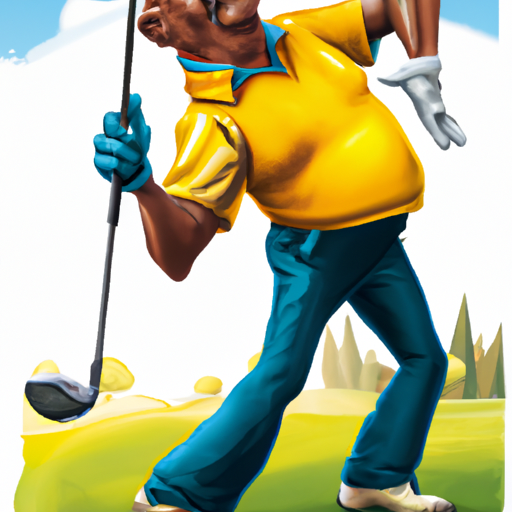- Home
- Golf Swing
- Half Swing Golf
Master the Half Swing Golf Technique: The Secret Weapon Every Weekend Golfer Needs to Know
As a weekend golfer, I know the struggles of inconsistency on the course. The fear of the first tee, the uncertainty of each shot, the constant search for the magic trick that will transform our game. But what if I told you there's a technique that could be your game-changer? Yes, it's the half swing golf technique.
The half swing technique is not about swinging the club halfway. It's about control, precision, and most importantly, consistency. It's about hitting the ball with accuracy, even if it means sacrificing a bit of distance.
Intrigued yet?
Imagine being able to lower your score, hit more accurate shots, and consistently win against your more experienced golfing buddies. Imagine having a secret weapon that gives you an edge every time you step onto the course. That's the power of the half swing.
So, are you ready to transform your golf game? Are you ready to master the half swing and become the golfer you've always wanted to be?
Let's dive in and discover the secret weapon every weekend golfer needs to know.
Unveiling the Half Swing Golf Technique: The Game Changer
As an inconsistent golfer, I've had my fair share of humiliating moments on the first tee. The pressure, the anticipation, and the fear of not hitting the ball right were all too familiar feelings. But then, I discovered the half swing golf technique, and it was a game-changer.
The half swing, contrary to what the name suggests, is not about swinging the club halfway. It's about control, precision, and, most importantly, consistency. It's about hitting the ball with accuracy, even if it means sacrificing a bit of distance.
Are you ready to get started?
Let's dive in.
Understanding the Half Swing
The half swing in golf is a technique where the golfer swings the club to a point where the club shaft is parallel to the ground, rather than a full backswing where the club is swung all the way back.
The benefits?
Improved control, increased accuracy, and a lower score.
I remember the first time I tried the half swing. It felt awkward, unnatural even. But as I practiced, I started to see the benefits. My shots were more accurate, and my score started to improve.
Isn't that exciting?
But there's more.
The Role of Equipment in Half Swing Golf
As a golfer who loves new equipment, I was curious to see how different clubs would affect my half swing. I experimented with different drivers, irons, and even golf balls. What I found was that while equipment can enhance your game, it's the technique that makes the most significant difference.
I've bought countless clubs and golf balls, hoping they would be the magic solution to my golfing woes. But the half swing taught me that it's not about the equipment; it's about how you use it.
So, what's the takeaway here?
Invest in good quality equipment, but don't forget to hone your skills and techniques.
Mastering the Half Swing
Mastering the half swing requires practice and patience. Here are some steps to get you started:
1. Position the ball: Place the ball in the middle of your stance.
2. Grip the club: Hold the club with a firm but relaxed grip.
3. Swing the club: Swing the club back until the club shaft is parallel to the ground.
4. Hit the ball: Strike the ball with a downward blow, ensuring your hands are ahead of the clubface at impact.
5. Follow through: Complete the swing with a balanced follow-through.
Remember, the key to a successful half swing is control and precision, not power.
Can you imagine if you mastered this technique? Your golf game would improve significantly.
But I didn't stop there.
The Impact of the Half Swing on Your Game
Incorporating the half swing into my game was a turning point. My scores started to lower, my shots became more accurate, and I began to win against my more experienced golfing buddies. The half swing became my secret weapon, my ace in the hole.
I remember one particular game where I was up against a golfer who was younger, stronger, and better equipped. I was nervous, but I stuck to my half swing technique.
And guess what?
I won.
So, what does this mean for you? It means that with the right technique, you too can improve your game and start winning.
The Golfeaser Manifesto and the Half Swing
The principles of the Golfeaser Manifesto align perfectly with the half swing technique. It's about improving your game, hitting long drives, impressing your buddies, and changing the world one round at a time.
As a weekend golfer, I live by this manifesto. I strive to improve my game, to hit those long drives down the fairway, and to earn my bragging rights in the clubhouse. And the half swing has been instrumental in helping me achieve these goals.
I remember the first time I broke 100, then 90, and then, finally, 80. Each milestone was a testament to the effectiveness of the half swing.
And the best part?
I did it even though I was overweight and didn't have much time to practice.
You're reading what I'm saying, right?
The half swing can be your secret weapon too.
Conclusion
The half swing golf technique is a game-changer for inconsistent golfers like me. It improves control, increases accuracy, and can significantly lower your score. While good quality equipment can enhance your game, it's the technique that makes the most significant difference.
Here are the key takeaways:
- The half swing is about control and precision, not power.
- Good quality equipment can enhance your game, but it's the technique that makes the most significant difference.
- The half swing aligns with the principles of the Golfeaser Manifesto, making it an effective technique for weekend golfers.
So, are you ready to try the half swing and change your golf game? After all, you're ready for success finally, aren't you?
Remember, golf is not just a game; it's a journey of self-improvement, one round at a time.
Onward, fellow golfers!
Let's change the world, one half swing at a time.
Comprehensive FAQ on Half Swing Golf
What is a half swing in golf?
What is a half swing in golf?
A half swing in golf refers to a swing where the club is brought back to a point where it's roughly parallel to the ground, rather than a full backswing where the club is brought all the way back. This type of swing is often used for shorter shots where precision is more important than distance.
Why should I use a half swing?
Why should I use a half swing?
The half swing is a great tool for improving your control and accuracy on the golf course. It's particularly useful for shots where you need more precision, such as when you're close to the green. Additionally, mastering the half swing can help improve your full swing by teaching you proper sequencing and connection.
How can I practice my half swing?
How can I practice my half swing?
To practice your half swing, start by setting up as you would for a normal shot. Then, instead of taking a full backswing, stop when your club is parallel to the ground. From this position, swing through to hit the ball. You can practice this with different clubs to get a feel for how it affects your shots.
What is the proper form for a half swing?
What is the proper form for a half swing?
The proper form for a half swing is similar to a full swing, but the club is only brought back to a point where it's roughly parallel to the ground. Your wrists should be fully hinged and your left arm (for right-handed golfers) should be parallel to the ground. This allows for a 90-degree angle between the club shaft and your left arm.
How does a half swing affect the distance of my shots?
How does a half swing affect the distance of my shots?
A half swing will typically result in shorter shots compared to a full swing. This is because you're not generating as much power with a half swing. However, what you lose in distance, you gain in control and accuracy, making the half swing a valuable tool for precise shots.
Can I use a half swing with any club?
Can I use a half swing with any club?
Yes, you can use a half swing with any club. However, it's most commonly used with wedges and short irons where precision is key. Using a half swing with a driver or long iron can be more challenging, but it can still be effective in certain situations.
What are some drills to improve my half swing?
What are some drills to improve my half swing?
There are many drills you can use to improve your half swing. One simple drill is to practice hitting shots with only a half swing. This can help improve your sequencing, arm speed, and impact alignments. Another drill is to imagine your golf swing as a clock, with 12:00 above your head, 9:00 directly to your right (for a righty), 6:00 at your feet and 3:00 directly to your left. Your half swing should go from 6:00 to 9:00 for a right-handed golfer.
How can mastering the half swing transform my golf game?
How can mastering the half swing transform my golf game?
Mastering the half swing can significantly improve your control and accuracy on the golf course. It can help you hit more precise shots, particularly when you're close to the green. Additionally, the skills you learn from practicing your half swing can also translate to your full swing, potentially improving your overall game.






















